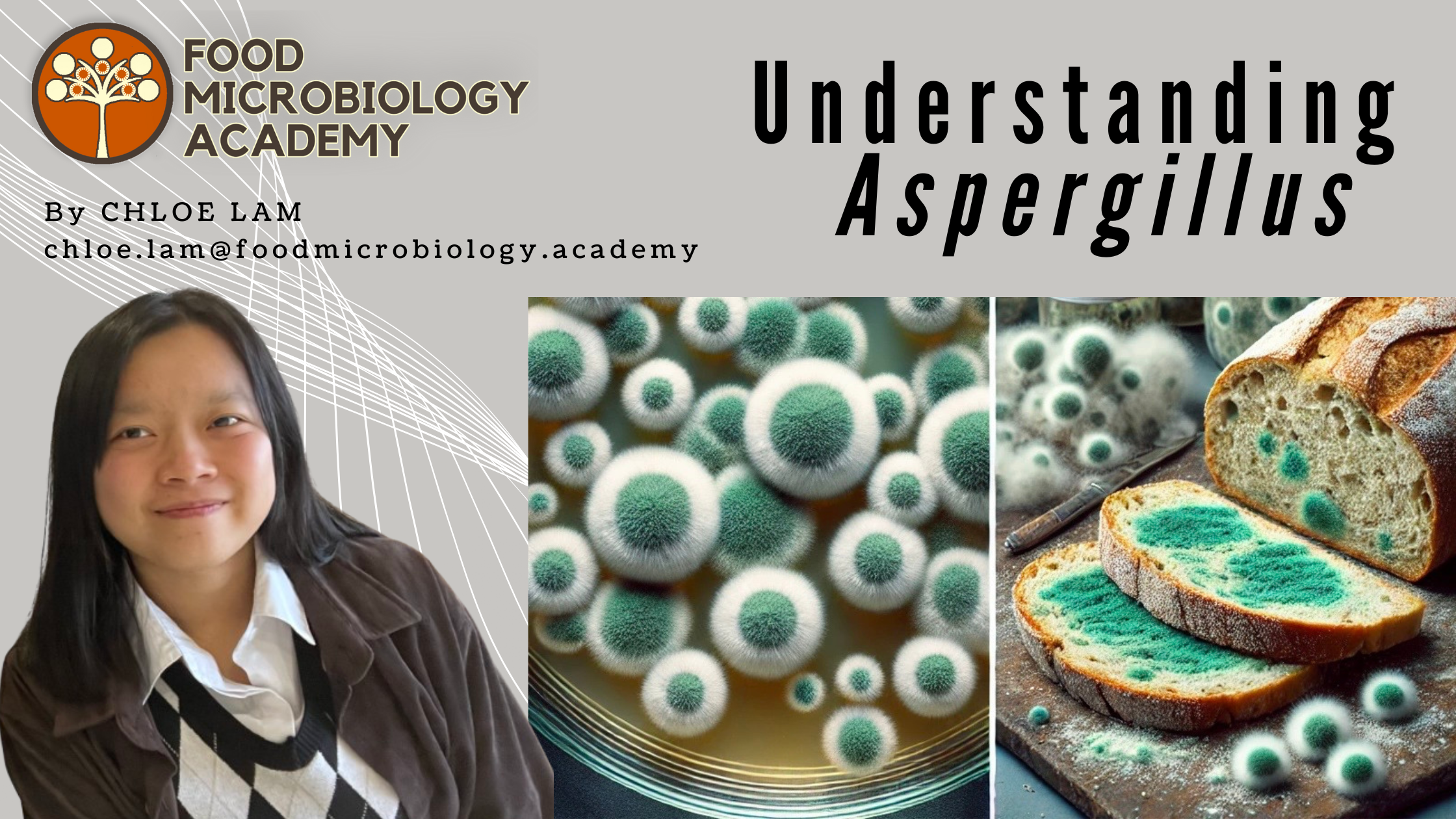By Chloe Lam – chloe.lam@foodmicrobiology.academy
CHLOE has more interest in mycology than other areas of microbiology, and therefore is sharing about Aspergillus species here, a key mould of much importance in food microbiology, as well as in medical microbiology. The clinical and public health significance of this genus is far-ranging, as is its economic burden. Not only is it worth knowing about, but we need a range of improved approaches, processes and methodologies to reduce the impacts and challenges caused by this mould. Chloe can be contacted directly on her e-mail address above – please don’t hesitate to to make contact with her to tap into her microbiology understanding.
Aspergillus is a genus of mould in the phylum of Ascomycota. It is a common type of fungus growing on decaying vegetables. They could be growing in a wide range of environmental conditions, including high temperature and dry environments. To date, there are more than 300 different types of Aspergillus identified.
Their distinctive reproductive system characterizes Aspergillus. They have a brush-like spore-producing system which produces asexual spores. Their reproductive hyphae, conidiophore is long and perpendicular to the vegetative hyphae. (see figure) These conidiophores would produce airborne spores conidia which are arranged in chains. Aspergillus also has a septate, multicellular mycelium. The mycelium consists of two layers of chitin.
Aspergillus has a significant impact on human health.

Aspergillus – Fungi that cause food poisoning
Image from: https://medicinalgenomics.com/aspergillus-dangerous-cannabis-pathogen/
Speaking of food poisoning, we would usually think of bacteria and viruses. Indeed, bacteria like E. coli and Salmonella, viruses, and parasites cause most food poisoning.
Apart from these common causes, Aspergillus can cause food poisoning. Aspergillus (Aspergillus flavus and Aspergillus parasiticus) primarily produces aflatoxin, a highly toxic compound. It is produced as a defence mechanism to protect the fungus. Aflatoxin is a mycotoxin that causes foodborne poisoning which can contaminate a wide range of crops, such as corn, peanuts, and cottonseed.
Food poisoning is a type of foodborne illness in which patients develop illness from what they consume. Pathogens would irritate the digestive tract, leading to a range of gastroenteritis symptoms. Some common gastroenteritis symptoms include vomiting, diarrhea, headaches, and fever. Food can be exposed to pathogens in any time of food manufacturing, from growing and harvesting to processing and transporting. Improper food handling practices, such as not cooking food thoroughly and leaving out food for too long, are the main causes of food poisoning. Microbes can spread and grow quickly in food, which provides a pool of nutrients for proliferation. Patients tend to recover from food poisoning within one to two days, however, in some cases, the symptoms could last up to four weeks after exposure.
Asperigllus in lungs – Aspergillosis
Besides food poisoning, Aspergillus can also cause Aspergillosis, a fungal infection typically affecting the respiratory system. The disease can cause severe, or even fatal pulmonary bleeding. It is caused by a type of fungus, Aspergillus. People with lung diseases (e.g. asthma and tuberculosis) and immunocompromised would be more susceptible to Aspergillosis. It is common for aspergillosis to relapse, which would require repeated treatment. Early diagnosis and treatments are essential to manage the disease.
Aspergillus can cause an acute pulmonary infection in 3 different ways:
- Allergic bronchopulmonary aspergillosis (ABPA)
Aspergillus has a higher ability to induce allergic bronchopulmonary aspergillosis in uncontrolled asthmatics, cystic fibrosis, lung disease patients, and immunocompromised patients. Some common symptoms of ABPA are wheezing, breathlessness, and worsening of asthma. This is caused by hypersensitivity reactions to aspergillus after it colonizes the airway.
Aspergillus is an allergen to some individuals. The immune system would be overactivated. Excess antibodies and inflammatory responses would be triggered upon the colonization of Aspergillus. This would lead to the constriction of the bronchi, lowering the capacity of the lung and causing chest tightness. A large amount of thick mucus would also be produced. This makes it harder for patients to cough out Aspergillus spores. It is common to find hyphae-filled mucus plugs in ABPA patients.
- Chronic pulmonary aspergillosis
Chronic pulmonary aspergillosis is an uncommon pulmonary disease with aspergillus colonizing and forming aspergilloma in scarred lung tissue. It is a long-term, slowly progressing form of aspergillosis that impacts immunocompromised individuals, usually with pre-existing or co-existing lung diseases.
- Invasive aspergillosis
Invasive aspergillosis is the most invasive form of aspergillosis. Infection occurs when the fungus spreads into blood vessels and other areas. Underlying lung disease and compromised immune system are risk factors for invasive aspergillosis. As the infection progresses, it can spread to the brain, heart, kidneys, and other organs, causing severe and life-threatening complications.



